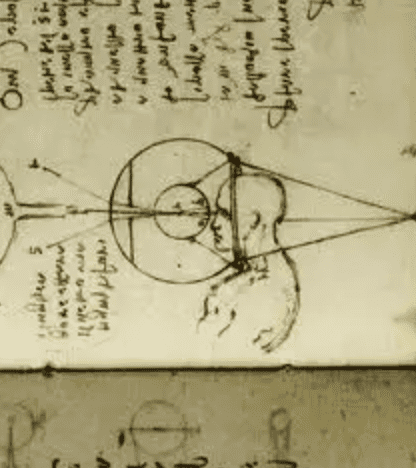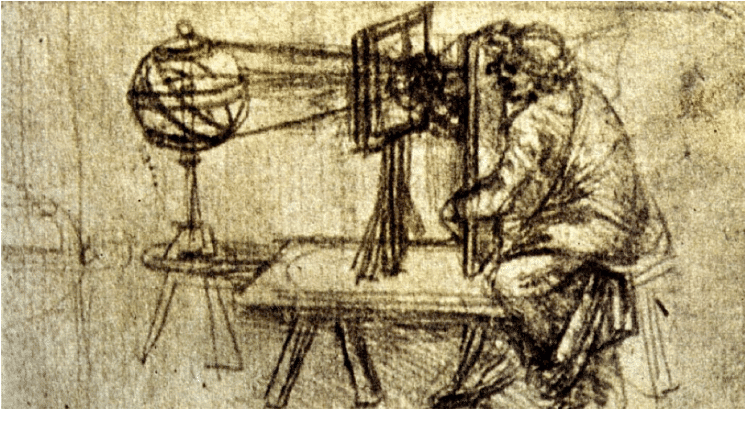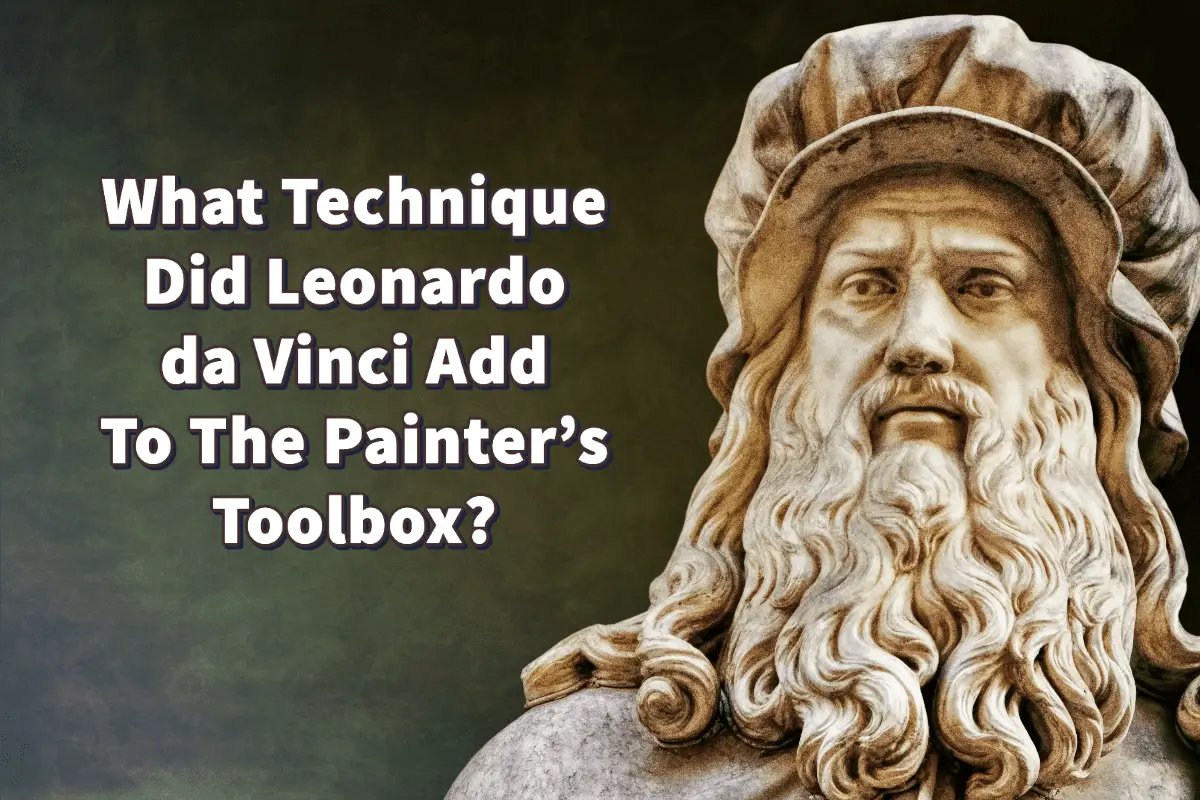Leonardo da Vinci is considered one of the world’s greatest artists. Leonardo was a highly skilled artist; his work is known worldwide.
Leonardo da Vinci added the “Sfumato” technique to the painter’s toolbox. The Sfumato technique is about an artist using a soft transition between the different colors and tones used by the artist. Many artists, including Leonardo, use this technique on the faces of their subjects to help give the human face a more realistic look and feel.
Table of Contents
- Leonardo da Vinci And Sfumato In The Painter’s Tool
- Where Does The Word Sfumato Come From?
- Leonardo da Vinci And The Sfumato Technique
- Other Prominent Artists That Used The Sfumato Technique
- Frequently Asked Questions
- Related Questions
Leonardo da Vinci And Sfumato In The Painter’s Tool
Leonardo da Vinci added the “sfumato” technique to the painter’s toolbox. Sfumato is a painting technique that Leonardo da Vinci used in his paintings; he described it as “without lines or borders.”

The Sfumato technique is most prominently seen in his works of the Virgin Of The Rocks and Mona Lisa. You can see in these paintings how there is no apparent transition between the colors that he is using. All the transitions are very soft.
Leonardo was the most prominent painter who used the Sfumato technique; he did not really invent the technique as much as to perfect it so that other painters could follow and use it.
Leonardo da Vinci – Sfumato and the Study of Optics
One of the reasons Leonardo used the Sfumato technique is his ongoing research and fascination with optics. Optics is the branch of physics that has to do with studying the behavior and properties of light.
Leonardo was intrigued with optics and spent a lot of time studying and learning about light. Learning about light or optics was vital to him as an artist and a scientist.
When Leonardo lived, people did not understand how the human eye functioned. Many people believed a person could see because light rays would bounce off the object and then return to the eye, allowing people to see. Leonardo felt that reasoning was wrong as the light ray would take too long to return to the eye.
Leonard set out to study optics and the human eye. In his scientific research, Leonardo proved that how people thought the eye worked was utterly wrong as to how the human eye functioned.
Leonardo da Vinci – Sfumato and The Human Eye

Another learning that led Leonardo to the Sfumato technique in painting was his intrigue with the human eye. Leonardo saw the human eye as an essential organ of the body.
He wrote about the human eye in his diary “this is the eye, the chief and leader of all others.” He was so taken with the studies of the human eye that he filed up a hundred pages in his notebooks about how he thought the human eye functioned.
In his study of the human eye, he dissected many human eyes. He developed projects that spoke about bifocals and even had an idea of what looks very close to the contact lenses we use today.
Today many believe that he first invented the telescope long before the Dutchman Hans Lippershey is credited with inventing the present-day telescope. Leonardo wrote this about his vision of a telescope and how to view the heavens and the sky:
“..in order to observe the nature of the planets, open the roof and bring the image of a single planet onto the base of a concave mirror. The image of the planet reflected by the base will show the surface of the planet much magnified.”
Leonardo da Vinci
Leonardo da Vinci – Sfumato And Camera Obscura

One of Leonardo’s most exciting inventions was the Camera Obscura. He was not the first to use the Camera Obscura, but he was the first to correlate how the Camera Obscura worked and the human eye.
A Camera Obscura is usually a dark box with a tiny hole that allows light. When you look at the projected image, the image is projected onto the wall upside down.
Leonardo’s study of optics, the human eye, and the Camera Obscura all helped lead him to use the sfumato technique in his paintings. The Sfumato technique was not just a haphazard technique, but like so many other things that Leonardo created, he spent a lot of time studying and perfecting the Sfumato technique in his artwork.
Where Does The Word Sfumato Come From?
Sfumato comes from the Italian word “fumo,” which means smoke or fume. When translated into English, Sfumato means soft, vague, or blurred.
In Italian, the word is often used as an adjective like “blondo sfumato,” which means pale blonde. Or it can be used as a verb, such as “l’affare e’ sfumato,” which would mean “the deal went up in smoke.”
We can credit Leonardo da Vinci as the person who created and perfected this technique and started using this word to describe his painting technique.
Leonardo da Vinci And The Sfumato Technique
When an artist uses the Sfumato technique, there is a soft transition between the different colors and tones used by the artist. Many artists use this when painting faces, as the softer transitions help to give a more realistic image.
Leonardo also used this technique for many of his backgrounds, where he blended the colors of the background to give a kind of smoke illusion.
Other Prominent Artists That Used The Sfumato Technique
Leonardo was not the only artist that used the sfumato technique. Some artists followed Leonardo, who was known as Leonardeschi.
Leonardeschi was a large group of artists who worked in Leonardo’s studio or under the influence of Leonardo da Vinci. Many artists who followed him and studied under him were in other parts of Europe.

Bernardo Luini and Funisi were considered part of the Leonardeschi group of artists.

Some of the other prominent artists who also used the sfumato technique included Antonio da Correggio, Raphael, and Giorgione. Raphael’s “Madonna of the Meadow” painting is an excellent example of Sfumato, especially around Mary’s face.
Leonardo da Vinci was a brilliant artist, and the way he was able to create the sfumato technique and use it in his paintings shows how brilliant he was. Today, many other artists, myself included, also try to master the sfumato painting technique, especially when painting faces.
Anita Louise Art is dedicated to art education, great artists, and inspiring others to find and create their art. We love art that uplifts and inspires. #ArtToMakeYouSmile! #ArtToMakeYouHappy!
If you want to see any of my art, you can find out more by clicking here. If you are interested in what inspires me and my paintings, you can discover more by clicking here.
We have a free newsletter and would love you to be part of our community; you can subscribe to the newsletter by clicking here. If you have any questions, I would be happy to talk to you anytime. You can reach me, Anita, by clicking here.
Subscribe to our Anita Louise Art YouTube Channel with great videos and information by clicking here.
Join us for our podcast “5 Minutes With Art.”Spend 5 minutes a week with us to discover and learn about great art and artists. You can find out more about our podcast by clicking here.
Frequently Asked Questions
What is the Sfumato technique, and how did Leonardo da Vinci contribute to its development?
Leonardo da Vinci is renowned for his artistic innovations. One notable addition to the painter’s toolbox was the Sfumato technique. Can you explain what this technique entails?
How does the Sfumato technique differ from other painting techniques, and what makes it unique?
Leonardo da Vinci’s contributions to art include the introduction of the Sfumato technique. How does this technique set itself apart from other traditional painting methods, and what distinctive qualities does it bring to the canvas?
In what ways did Leonardo da Vinci employ the Sfumato technique in his artworks, and can you provide examples of its application?
Leonardo da Vinci’s mastery of the Sfumato technique is evident in his artworks. Can you elaborate on specific instances where he effectively utilized this technique, and what impact did it have on the overall aesthetic of his paintings?
How does the Sfumato technique enhance the portrayal of human faces in art, and why did Leonardo da Vinci choose to apply it to facial features?
One key aspect of the Sfumato technique is its application to human faces. Could you elaborate on how this technique enhances the realism of facial features, and why Leonardo da Vinci found it particularly effective for this purpose?
Were there any challenges or criticisms that Leonardo da Vinci faced when introducing the Sfumato technique, and how did the art community respond to this innovation?
Introducing a new technique often comes with challenges. Were there any obstacles or criticisms faced by Leonardo da Vinci in popularizing the Sfumato technique, and how did the art community react to this innovative approach?
How did the Sfumato technique influence other artists of Leonardo da Vinci’s time, and did it become a widespread practice in the art world?
Leonardo da Vinci’s influence on art is profound. How did the Sfumato technique impact other artists during his era, and did it become a widely adopted practice in the art world?
Can you explain the technical aspects of the Sfumato technique and how artists incorporate it into their painting process?
For those unfamiliar with the technicalities of the Sfumato technique, could you provide an explanation of how artists, including Leonardo da Vinci, incorporate this method into their painting process?
How does the Sfumato technique contribute to the overall atmosphere and mood of Leonardo da Vinci’s paintings?
Beyond enhancing realism, the Sfumato technique also plays a role in setting the mood of a painting. Can you discuss how Leonardo da Vinci utilized this technique to create a specific atmosphere in his artworks?
Related Questions
What Did Leonardo da Vinci Contribute To The Renaissance?
Leonardo da Vinci made many contributions to the Renaissance in art, science, engineering, medicine, and architecture. He was a keen observer who wrote down a lot of what he discovered in his notebooks. His artistic techniques changed how artists painted and influenced many other Renaissance artists.
By clicking here, you can learn more by reading What Did Leonardo da Vinci Contribute To The Renaissance?.
Mona Lisa Painting And The Paris Louvre Museum
The Mona Lisa is one of the key paintings of the Louvre Museum. It is one of the most visited paintings in the world. The Mona Lisa is a painting studied, sung about, written about, and spoken about. There is still a mystery surrounding exactly who the Mona Lisa is and why Leonardo da Vinci painted it. This mystery adds to the allure of the painting.
By clicking here, you can learn more by reading Mona Lisa Painting And The Paris Louvre Museum.


